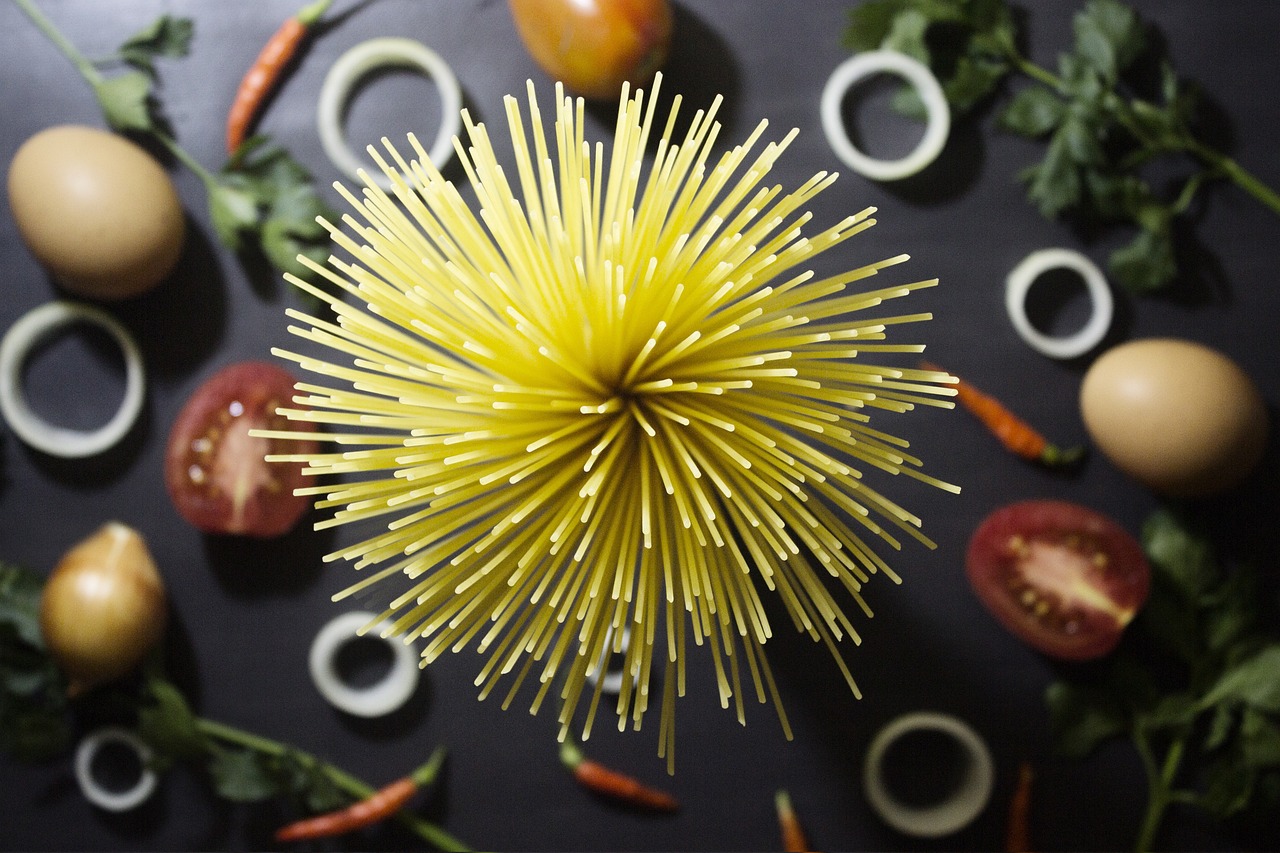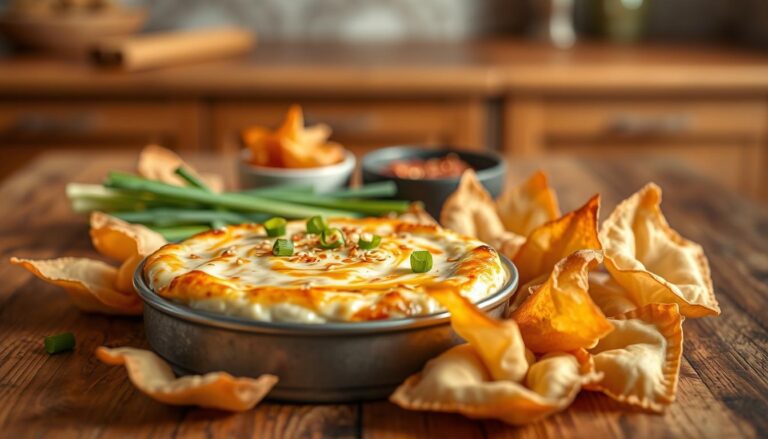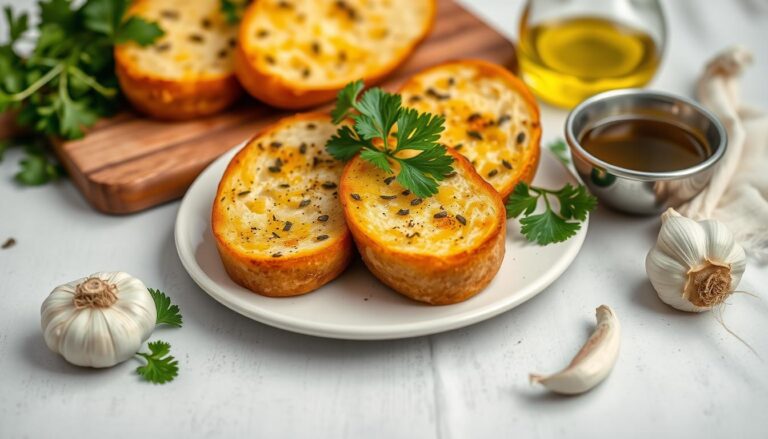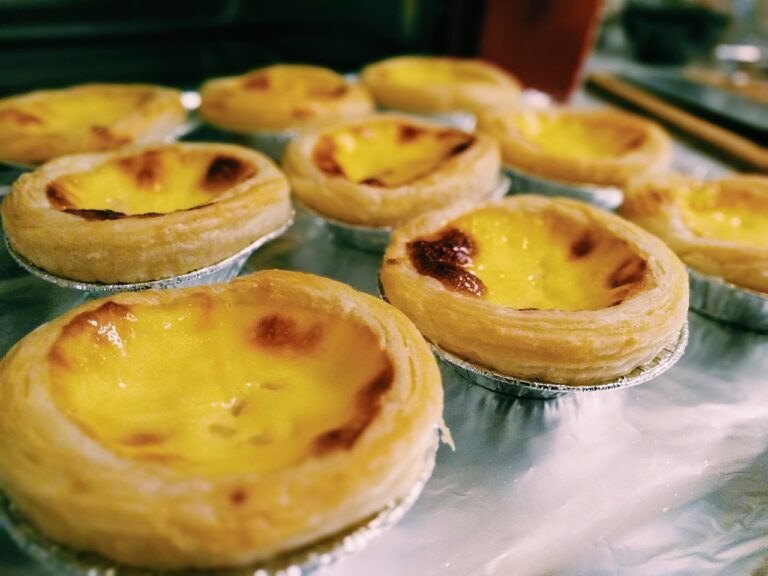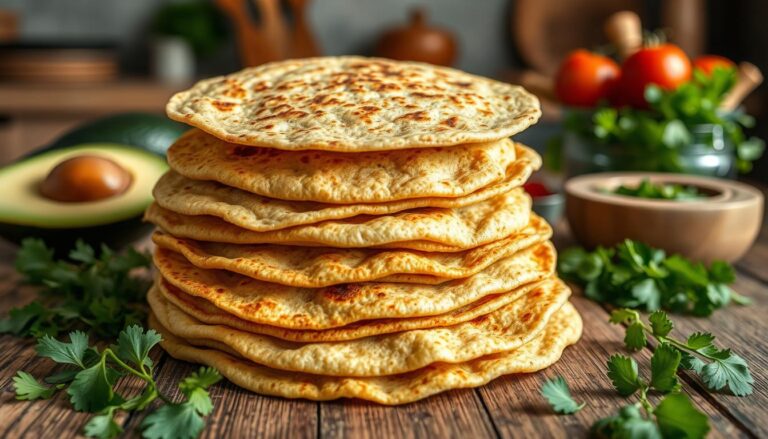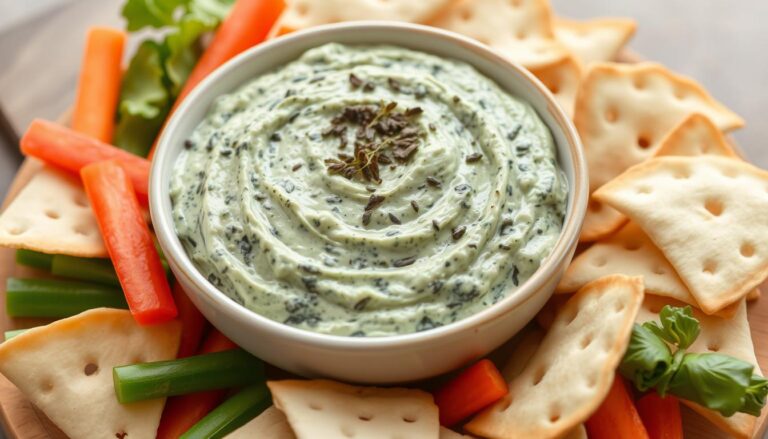Classic Pasta Primavera Recipe
Pasta Primavera is a beloved Italian dish loved by many. It celebrates fresh, seasonal vegetables, making every bite a taste of spring. This dish has a rich history, starting in the 1970s in New York City. It has grown from a simple dish to a favorite for quick, healthy dinners.
The dish’s beauty is in its use of fresh vegetables. It pairs them with perfectly cooked pasta and a light sauce. Whether you’re watching your diet or just want a tasty meal, this recipe is a winner.

Key Takeaways
- Pasta Primavera is a classic Italian dish featuring a variety of fresh, seasonal vegetables
- The dish originated in New York City in the 1970s and has since become a popular choice for a quick, healthy dinner
- Pasta Primavera showcases the natural sweetness and crunch of vegetables, paired with perfectly cooked pasta and a light, creamy sauce
- This recipe is versatile and can be customized to suit individual preferences and dietary needs
- Pasta Primavera is a delicious and nutritious option for health-conscious food lovers
Understanding the Classic Italian Pasta Primavera Recipe
Pasta primavera is a favorite dish around the world. It’s known for its vibrant flavors and rich history. This dish comes from the Italian peninsula’s culinary traditions.
Origins of Pasta Primavera
The dish became popular in the 1970s in the United States. Its name, “primavera,” means “spring” in Italian. It highlights the use of fresh, seasonal vegetables.
Key Ingredients and Their Significance
The core of pasta primavera is pasta, fresh vegetables, and a creamy sauce. Long, thin pasta like spaghetti or linguine is often used. It lets the colorful vegetable pasta shine.
The vegetables, such as asparagus, peas, and bell peppers, add to the dish’s beauty. They also bring out the seasonal recipes and balanced flavors.
Traditional vs Modern Variations
While the traditional recipe stays the same, modern twists have appeared. Chefs now try different pasta shapes and add more vegetables. They also experiment with sauce bases, keeping the dish’s essence intact.
Despite the changes, pasta primavera celebrates fresh, seasonal produce. It blends these ingredients with the comfort of Italian cuisine.
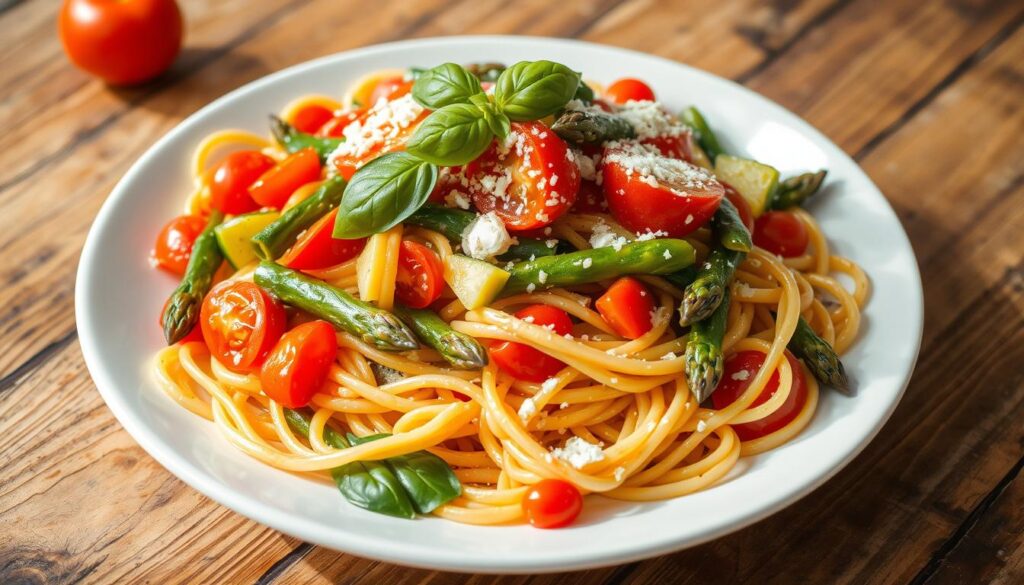
Essential Ingredients for Perfect Pasta Primavera
Making a tasty pasta primavera needs the right mix of fresh, tasty ingredients. Whether you love traditional pasta recipes or want to try vegetarian pasta recipes, the secret to a great pasta primavera is in the ingredients. Let’s explore the key parts that make your healthy pasta meals stand out.
The base of any pasta primavera is the pasta. You can use spaghetti or linguine, but feel free to try other shapes like penne or farfalle. You can also choose whole-wheat or gluten-free pasta for different diets.
The dish is known for its colorful, fresh veggies. You’ll usually see a mix of:
- Asparagus
- Zucchini
- Bell peppers
- Cherry tomatoes
- Peas
- Broccoli florets
These veggies bring color, crunch, and lots of nutrients to your pasta recipes.
To make the flavors pop, add fresh herbs like basil, parsley, and chives. A bit of garlic and some Parmesan cheese can also make a big difference. For a vegetarian pasta recipes or healthy pasta meals, try vegan-friendly options like nutritional yeast or plant-based cheese.
With these key ingredients, you’re set to make a delicious pasta primavera. It will please your taste buds and be good for you. Get ready to enjoy the vibrant flavors and textures of this Italian favorite!
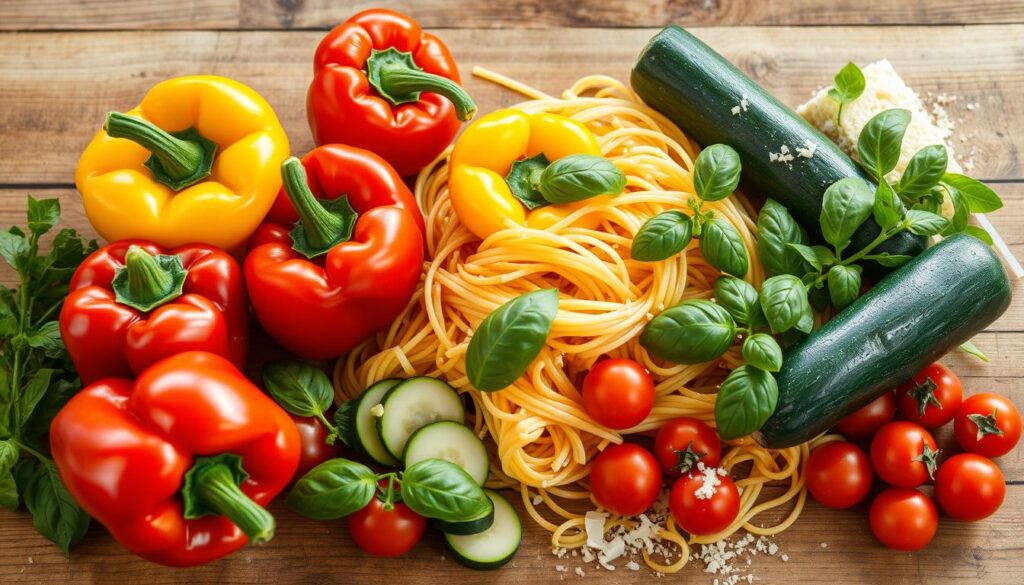
Step-by-Step Cooking Instructions
Making the perfect pasta primavera is a fun journey. Follow these steps to make a colorful, tasty, and quick weeknight dinner.
Preparing the Vegetables
Start by washing and trimming fresh veggies. Cut asparagus, bell peppers, and zucchini into thin strips. Chop garlic and shallots finely. These will add great flavor to your easy pasta dish.
Cooking the Perfect Al Dente Pasta
Boil a big pot of salted water. Add pasta and cook until it’s al dente, about 8-10 minutes. Drain it, keeping a cup of water for the sauce.
Creating the Signature Sauce
In a large skillet, cook garlic and shallots in olive oil until they smell good. Add the veggies and cook for 5-7 minutes, until they’re just tender. Then, add white wine or broth to enhance flavors. Mix in cooked pasta, some reserved water, and lemon juice. Toss until the sauce covers the pasta well.
Follow these steps to make a pasta primavera recipe that looks great and tastes amazing. It’s perfect for a quick weeknight dinner or a special occasion.
Tips for Customizing Your Vegetable Pasta
Pasta primavera is super versatile. You can make it your own by trying new ingredients and flavors. This way, you get a dish that’s both unique and delicious.
Seasonal Vegetable Variations
Using fresh, seasonal veggies is key to pasta primavera. Don’t just stick to the usual mix. In spring, add asparagus, peas, and herbs. Summer brings zucchini, bell peppers, and cherry tomatoes. Fall is perfect for butternut squash, Brussels sprouts, and kale.
Protein-Packed Additions
Want a heartier pasta? Add lean proteins like grilled chicken, shrimp, or tofu. Chickpeas or white beans are great for vegetarians. They make the dish more filling and nutritious.
Sauce Substitutions
While the classic sauce is tasty, try new ones too. A lemony olive oil sauce, pesto, or a light tomato sauce can be great. They add flavor and make your pasta special.
By mixing up ingredients, proteins, and sauces, you can make pasta primavera your own. It’s a chance to show off your cooking skills and taste. The options are endless, making it a fun dish to customize.
Storage and Reheating Guidelines
Enjoying pasta primavera doesn’t have to stop after one meal. With the right storage and reheating, you can enjoy it again. Here’s how to keep your pasta primavera fresh and tasty.
Proper Storage Methods
To keep your pasta primavera fresh, store it right. Put it in an airtight container and refrigerate for 3-4 days. This keeps the flavors and prevents the veggies from wilting. You can also freeze it for 2-3 months.
Best Practices for Reheating
To reheat pasta primavera, avoid overcooking. The best way is to heat it in a skillet over medium heat. Add a bit of water or broth to keep the pasta and veggies tender. You can also use the microwave, stirring often for even heating.
Make-Ahead Options
- Prepare the veggies ahead and store them in the fridge. Add them to the pasta when you’re ready to cook.
- Cook the pasta early and toss it with oil to prevent sticking. Then, reheat and mix with veggies and sauce.
- Make the sauce ahead and store it separately. Heat it up and toss with pasta and veggies for a quick meal.
Follow these tips for storing and reheating pasta primavera. This way, you can enjoy it all week long. These easy tips will help you keep the dish’s texture and taste perfect.
Conclusion
The pasta primavera recipe is a classic in Italian cuisine. It’s loved for its mix of fresh veggies, al dente pasta, and creamy sauce. This dish is not only tasty but also easy to make your own, fitting any season.
Looking for a comforting spring pasta or a new Italian pasta dish? Pasta primavera is a great pick. It’s simple to make and full of flavor, perfect for any meal.
We suggest trying new things with this dish. Mix up the veggies, try different pasta shapes, and tweak the sauce. Pasta primavera lets you highlight the best of the season and please your taste buds. Enjoy!
FAQ
What is pasta primavera?
Pasta primavera is a classic Italian dish. It’s made with fresh spring vegetables and pasta in a light sauce.
What are the key ingredients in pasta primavera?
Pasta primavera includes fresh veggies like asparagus, peas, and bell peppers. You also need pasta and a light sauce. The sauce is often olive oil, garlic, and herbs.
Can I make pasta primavera vegetarian or vegan?
Yes, you can! Just skip the animal products like Parmesan cheese. Use plant-based alternatives instead.
How do I prepare the vegetables for pasta primavera?
Start by cleaning and chopping the veggies into small pieces. Cut them the same size for even cooking. You can sauté or blanch them before adding to the pasta.
How do I cook the pasta for the perfect texture?
Cook the pasta al dente, following the package instructions. Drain it while still firm. It will cook a bit more in the sauce.
Can I make pasta primavera ahead of time?
Yes, you can make it ahead. Store the pasta, veggies, and sauce in the fridge. Reheat and toss when you’re ready. It’s great for busy nights.
How should I store and reheat leftover pasta primavera?
Store it in airtight containers in the fridge for 3-4 days. Reheat by warming the components gently. Add a bit of water or broth to keep the pasta moist.

